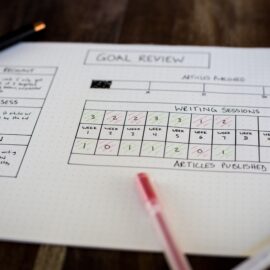

This article is an excerpt from the Shortform book guide to "Mastering the Rockefeller Habits" by Verne Harnish. Shortform has the world's best summaries and analyses of books you should be reading.
Like this article? Sign up for a free trial here.
What metrics truly reveal your company’s financial health? How can you use these key measurements to prevent business problems before they start?
Tracking the right profitability indicators helps business owners spot market changes and budget issues early. By monitoring specific metrics in real time, companies can adapt quickly and maintain steady growth without getting overwhelmed.
Keep reading to discover how to choose the right metrics and set benchmarks that will keep your business thriving.
Profitability Indicators
In Mastering the Rockefeller Habits, Verne Harnish highlights the importance of identifying metrics that give a clear impression of your company’s financial health and general productivity. We’ll call these metrics “profitability indicators” (Harnish refers to them as “Smart Numbers”). For example, a social media platform’s profitability indicators could be the percentage change in the number of new users this week compared to last week, the ROI for this week’s advertisements, and the percentage of users who used the social media platform every day.
According to Harnish, studying your company’s profitability indicators in real time allows you to detect rapidly changing market conditions and unforeseen budget problems caused by your company’s growth. Unless you have systems in place to collect and review these Indicators regularly, it’s impossible to adapt your strategy quickly enough to handle these sudden problems.
Discerning which metrics to track requires some experimentation—start by gathering all data you think might accurately predict your future performance. Over time, focus on those metrics that yield the most effective predictions.
(Shortform note: In The Lean Startup, Eric Ries advises that when you’re experimenting with metrics, start by tracking those with the power to disprove the riskiest assumptions you have about your business. For example, imagine a social media platform believes that they can get 5,000 new users every week. If they need 5,000 users a week to raise enough advertising revenue to keep the business afloat, believing they can attract these users is a risky assumption. Thus, they should track the metric of “number of new users every week” as soon as possible.)
| Set Minimum Benchmarks for Each Profitability Indicator Like Harnish, Mike Michalowicz in Clockwork recommends tracking metrics that indicate your company’s overall health. To make this tool more effective, he also suggests creating a benchmark for each Profitability Indicator—a numeric value that signals failure if the metric drops below it. For example, if a social media platform chooses the Profitability Indicator of the percentage of users that use its app every day, they may set a benchmark of 50%. If their percentage of daily users dips below 50%, it indicates there’s a problem, and they need to do something to boost engagement. Michalowicz designed this system to help entrepreneurs avoid getting burnt out. Typically, when entrepreneurs encounter sudden problems with their business—such as those caused by turbulent market conditions or sudden growth—they scramble to personally fix it. Unfortunately, no one person can solve every problem with their business themselves, so entrepreneurs often get overwhelmed and ultimately lose motivation to run the business. In contrast, the benchmark system allows entrepreneurs to detect problems while they’re in early, preventable stages. This removes pressure and gives entrepreneurs the time they need to develop systems that allow their organization to quickly adapt its strategy on the fly. This empowers the organization to solve problems before they evolve into full-blown crises. |

———End of Preview———
Like what you just read? Read the rest of the world's best book summary and analysis of Verne Harnish's "Mastering the Rockefeller Habits" at Shortform.
Here's what you'll find in our full Mastering the Rockefeller Habits summary:
- What an oil tycoon can teach you about business
- How knowing your business’s unique value is key to beating the competition
- Why you should create fun themes for your quarterly goals






